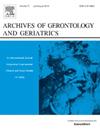农村老龄化人口认知障碍风险的时间分层建模:Nomogram开发(2011)和外部验证(2013)使用CHARLS
IF 3.8
3区 医学
Q2 GERIATRICS & GERONTOLOGY
引用次数: 0
摘要
随着中国人口的老龄化,认知障碍已成为一个紧迫的公共卫生问题。农村老年人面临着不成比例的更高风险,但在预测模型研究中仍未得到充分代表。本研究旨在开发并外部验证一个nomogram来评估中国农村老年人的认知障碍风险。方法数据来自2011年中国健康与退休纵向研究(CHARLS)中2228名年龄≥60岁的农村参与者,随机分为培训组和内部验证组。另外从2013年CHARLS波中选取1854名农村参与者作为外部验证集。使用最小绝对收缩和选择算子(LASSO)进行特征选择,然后使用多变量逻辑回归来识别独立预测因子。构建模态图,通过ROC曲线、校正图和决策曲线分析(DCA)评价模型的性能。结果年龄、受教育程度、饮酒、收缩压、握力和抑郁症状6个预测因子被纳入最终的nomogram。该模型的auc分别为0.849(训练)、0.852(内部验证)和0.806(外部验证),表明该模型具有较强的判别能力。校正显示预测结果与观测结果吻合良好。DCA在所有队列中显示出良好的临床效用。结论该nomogram具有较强的预测能力和通用性,为中国农村认知障碍人群的早期识别提供了一种经济实用的工具。本文章由计算机程序翻译,如有差异,请以英文原文为准。
Time-stratified modeling of cognitive impairment risk in rural aging populations: Nomogram development (2011) and external validation (2013) using CHARLS
Background
With China's aging population, cognitive impairment has become a pressing public health issue. Rural older adults face disproportionately higher risks, yet remain underrepresented in predictive modeling studies. This study aimed to develop and externally validate a nomogram to estimate cognitive impairment risk among rural older adults in China.
Methods
Data were obtained from 2228 rural participants aged ≥60 years in the 2011 China Health and Retirement Longitudinal Study (CHARLS), randomly assigned to training and internal validation cohorts. An additional 1854 rural participants from the 2013 CHARLS wave served as an external validation set. Feature selection was conducted using the least absolute shrinkage and selection operator (LASSO), followed by multivariable logistic regression to identify independent predictors. A nomogram was constructed, with model performance evaluated through ROC curves, calibration plots, and decision curve analysis (DCA).
Results
Six predictors—age, education, alcohol consumption, systolic blood pressure, handgrip strength, and depressive symptoms—were included in the final nomogram. The model achieved AUCs of 0.849 (training), 0.852 (internal validation), and 0.806 (external validation), indicating strong discriminative ability. Calibration showed good agreement between predicted and observed outcomes. DCA demonstrated favorable clinical utility across all cohorts.
Conclusion
The nomogram exhibited strong predictive performance and generalizability, offering a cost-effective and practical tool for early identification of cognitive impairment in underserved rural populations in China.
求助全文
通过发布文献求助,成功后即可免费获取论文全文。
去求助
来源期刊
CiteScore
7.30
自引率
5.00%
发文量
198
审稿时长
16 days
期刊介绍:
Archives of Gerontology and Geriatrics provides a medium for the publication of papers from the fields of experimental gerontology and clinical and social geriatrics. The principal aim of the journal is to facilitate the exchange of information between specialists in these three fields of gerontological research. Experimental papers dealing with the basic mechanisms of aging at molecular, cellular, tissue or organ levels will be published.
Clinical papers will be accepted if they provide sufficiently new information or are of fundamental importance for the knowledge of human aging. Purely descriptive clinical papers will be accepted only if the results permit further interpretation. Papers dealing with anti-aging pharmacological preparations in humans are welcome. Papers on the social aspects of geriatrics will be accepted if they are of general interest regarding the epidemiology of aging and the efficiency and working methods of the social organizations for the health care of the elderly.

 求助内容:
求助内容: 应助结果提醒方式:
应助结果提醒方式:


